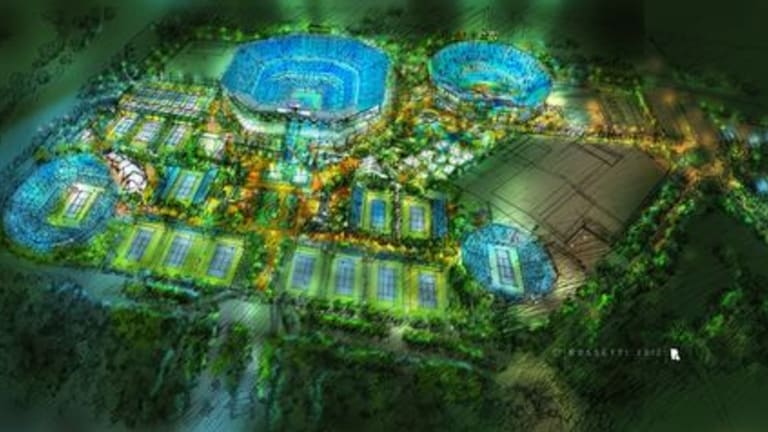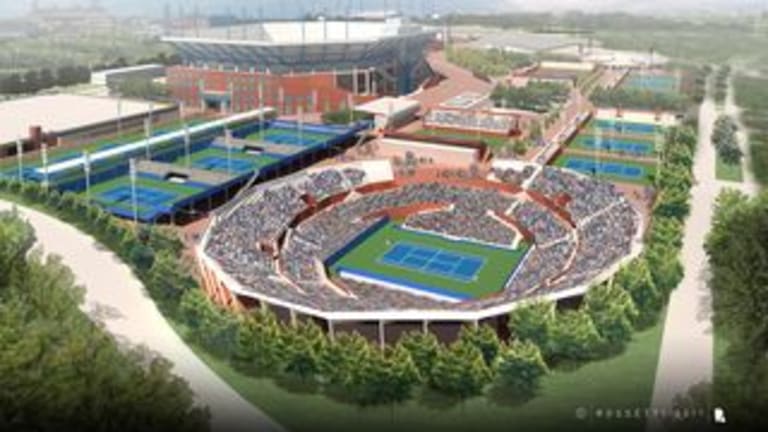*
by Pete Bodo*
NEW YORK—The USTA unrolled a massive, $500 million, seven-year renovation and expansion plan for its Billie Jean King National Tennis Center today, but the reaction of most administrators, pundits, and fans is likely to be the same one experienced by many in attendance at today's press conference: What, $500 million and no roof on Arthur Ashe Stadium?
This is an unfortunate situation, but that won't make it go away. The only thing that can make it go away would be, say, two or three years of finals weekends uninterrupted by rain—something which the U.S. Open hasn't enjoyed for four consecutive years. In U.S. tennis, Monday is the new Sunday. We're looking at a fifth consecutive Monday men's final should the prevailing weather trend continue.
"We simply do not have a roof design that works at this point," USTA executive director and chief operating officier Gordon Smith admitted. "We have been working on that, and will continue to work on it with engineers and architects."
The main problem for the USTA is twofold: First, Ashe Stadium is built on land that, in layman's terms, might just as well be called a swamp. The sheer size of the stadium, the largest of the Grand Slam venues with a capacity of 23,200, is the other impediment. The entire Wimbledon Centre Court could fit into the hole of the donut called Ashe Stadium. The span at the top of Ashe is fully five times that of the retractable roof that was retro-fitted to Centre Court and unveiled in 2009.
A marvel of engineering and design (it's a beautiful thing in its own right), the Centre Court roof at Wimbledon suddenly made roofed stadia not merely state-of-the-art, but seemingly obligatory. Never mind for a moment that Wimbledon's roof has proven as crucial to the tournament as a rowboat is to a sand dune. The Australian Open has roofs over two of its stadia, with plans for covering a third.
This roof thing has taken on a life of it's own, and for that reason you really have to feel for the USTA. The greater the fever, the more Ashe stadium is bound to be regarded somewhat contemptuously as a white elephant, a too-big-to-fail edifice that has a solid quarter-century of use left, but cannot be kitted out with a roof under any plan known to the USTA. Or any plan that makes sense at all levels.
Building a new, roofed stadium comparable to Ashe would cost, according to some estimates, close to a billion dollars. Retro-fitting a roof to Ashe, aside from the engineering problems it presents, would fall more within the $125 to $250 million dollar range. It would also require the use of an enormous amount of the space around the stadium for columns of pillars to hold the super-structure.
According to Smith, an investment of that size in a roof that may not even be used during a semi or a final for years would leave the organization without the resources to complete many of the improvements unveiled today—see the image at the top of this post. Those include replacing Louis Armstrong Stadium and the connected Grandstand (a favorite of many in-the-know fans) with a brand new Louie in the northeast corner of the grounds, and a new Grandstand on land that is currently part of the USTA's lease but unused. (Unlike Ashe, the Armstrong/Grandstand complex is nearly 50 years old and at the end of its useful life.) The USTA also resisted putting a roof on the new Louis Armstrong Stadium because it would have to hold at least the same capacity as Ashe to make it feasible to send patrons from one stadium to the other if rain came.
This, and some of the other changes, will also have a comfort dividend, as improving traffic flow and relieving congested areas has been a target of the improved site since the get-go. Other enhancements include widening some of the walkways (which involves moving some of the southern-most courts), a few new buildings, and at least one very welcome and innovative feature: A covered, elevated walkway and seating area extending out from Ashe, from which fans will be able to watch players practice.
Those of you who have attended tennis events in person know how staking out the practice courts has become a wildly popular fan pastime, even though the practice courts are usually located in the least crowd- and traffic-friendly areas of a venue. "Fans will be able to sit and watch their favorite players practice," Smith said, "and we're even going to post the practice schedules."
This project is no mere facelift, it's a makeover of the entire site surrounding Ashe. And it was guided by the USTA's awareness that there have been six new or upgraded stadium projects (representing an investment of $6.3 billion) with a 17-mile radius of Flushing Meadows. It's not just a matter of keeping up with the joneses; in fact, you can argue that biting the bullet on the outcry for a roof demonstrates that the USTA isn't just following the trend. The USTA also has resisted becoming Ashe-centric, which is not just a good thing for fans in general, but also for the tournament as a whole.

